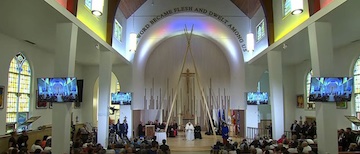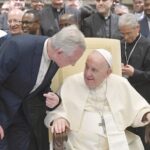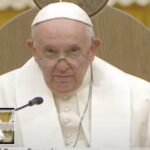Pope Francis’ meeting with indigenous peoples and members of the parish community
Church of the Sacred Heart in Edmonton – Monday, July 25, 2022
Pope Francis’ address
Dear Brothers and Sisters,
I am happy to be among you and to see again the faces of several indigenous representatives who a few months ago came to visit me in Rome. That visit meant a lot to me: now it is I in your home, as a friend and pilgrim, I am in your land, in the temple where you are to praise God as brothers and sisters. In Rome, after listening to you, I told you that “an effective process of healing requires concrete actions“. I am pleased to see that in this parish, in which people from different communities of the First Nations, métis and Inuit converge, together with non-indigenous people from local neighbourhoods and various immigrant brothers and sisters, this process has already begun. This is a home for all, open and inclusive, as must be the Church, the family of God’s children where hospitality and welcome, typical values of indigenous culture, are essential: where everyone must feel welcome, regardless of past events and individual life circumstances. And I would also like to say thank you for your concrete closeness to so many poor people – this touches me very much – who are also numerous in this rich country, through charity: this is what Jesus desires, who told us and always repeats to us in the Gospel: “All that you have done to one of the least of these my brethren, you did it to me” (Mt 25:40). It is Jesus present there.
And at the same time, we must not forget that even in the Church the good wheat is mixed with ‘weeds’. Even in the Church. And precisely because of this ‘weeds’ I wanted to undertake this penitential pilgrimage and begin it this morning by remembering the evil suffered by the indigenous peoples by so many Christians and asking for forgiveness with pain. It hurts me to think that Catholics contributed to the policies of assimilation and liberation that conveyed a sense of inferiority, robbing communities and people of their cultural and spiritual identities, severing their roots and nurturing prejudicial and discriminatory attitudes, and that this was also done in the name of an education that was supposed to be Christian. Education must always start from the respect and promotion of the talents that are already in people. It is not and can never be something pre-packaged to be imposed, because educating is the adventure of exploring and discovering together the mystery of life. Thank God, in parishes like this, through encounter, the foundations for healing and reconciliation are built day after day. Healing, reconciliation. I would like to say something that is not written here. I want to thank you in a special way for the work that the Bishops have done to ensure that I could come here, and that you were able to come there [to Rome]. A united Bishops’ Conference makes great gestures, it bears much fruit. Many thanks to the Bishops’ Conference!
Reconciliation:
It is on this word that I would like to share some reflections tonight. What does Jesus suggest to us when he speaks of reconciliation? Or when reconciliation inspires us? What does reconciliation mean to us today? Dear friends, the reconciliation wrought by Christ was not an external peace agreement, a sort of compromise to please the parties. Nor was it a peace descended from heaven, coming by imposition from above or by absorption of the other. The Apostle Paul explains that Jesus reconciles by putting together, making two distant realities a single reality, one, one people. And how does he do it? Through the Cross (cf. Eph 2:14). It is Jesus who reconciles us among ourselves on the cross, on that tree of life, as the ancient Christians liked to call him. The cross, tree of life.
You, dear indigenous brothers and sisters, have much to teach about the vital meaning of the tree which, joined to the earth by its roots, gives oxygen through its leaves and nourishes us with its fruits. And it is beautiful to see the symbolism of the tree represented in the physiognomy of this church, where a trunk joins to the ground an altar on which Jesus reconciles us in the Eucharist, an “act of cosmic love” that “unites heaven and earth, embraces […] all creation” (Lit. enc. Laudato si’, 236). This liturgical symbolism reminds me of a wonderful passage pronounced by Saint John Paul II in this country: “Christ animates the very centre of every culture, so that not only christianity concerns all the Indian peoples, but Christ, in the members of his body, is himself Indian” (Liturgy of the Word with the Indians of Canada , 15 September 1984). And it is he who on the cross reconciles, puts together what seemed unthinkable and unforgivable, embraces everyone and everything. Everyone and everything: the indigenous peoples attribute a strong cosmic meaning to the cardinal points, understood not only as geographical reference points but also as dimensions that embrace the whole reality and indicate the way to heal it, represented by the so-called “medicine wheel”. This temple makes its own this symbolism of the cardinal points and attributes to it a Christological meaning. Jesus, through the ends of his cross, embraces the cardinal points and brings together the most distant peoples, Jesus heals and pacifies everything (cf. Eph2:14). There he fulfills God’s plan: “to reconcile all things” (cf. Col 1:20).
Brothers, sisters, what does this mean for those who carry such painful wounds inside? I imagine the effort, in those who have suffered tremendously because of men and women who had to bear witness to Christian life, to see any prospect of reconciliation. Nothing can erase the dignity violated, the evil suffered, the trust betrayed. Nor should the shame of us believers ever be erased. But we must start again and Jesus does not propose words and good intentions, but proposes to us the cross, that scandalous love that allows its feet and wrists to be pierced by nails and pierced the head of thorns. This is the direction to follow: to look together at Christ, the betrayed and crucified love for us; look at Jesus, crucified in so many students of residential schools. If we want to be reconciled with each other and within ourselves, reconciled with the past, with the wrongs suffered and with the wounded memory, with traumatic events that no human consolation can heal, if we want to truly reconcile our gaze must be raised to Jesus crucified, peace must be drawn from his altar. Because it is precisely on the tree of the cross that pain is transformed into love, death into life, disappointment into hope, abandonment into communion, distance into unity. Reconciliation is not so much our work, it is a gift, it is a gift that flows from the Crucified One, it is peace that comes from the Heart of Jesus, it is a grace that must be asked for. Reconciliation is a grace that must be asked for.
There is another aspect of reconciliation that I would like to talk to you about. The Apostle Paul explains that Jesus, through the cross, reconciled us into one body (cf. Eph 2:14). What body are you talking about? He speaks of the Church: the Church is this living body of reconciliation. But, if we think of the indelible pain felt in these places by so many within ecclesial institutions, it comes only from feeling anger, it comes only from feeling shame. This happened when believers allowed themselves to be worldly and, instead of promoting reconciliation, imposed their cultural model. This attitude, brothers and sisters, is hard to die, even from a religious point of view. In fact, it would seem more convenient to inculcate God in people, rather than allowing people to draw near to God – a contradiction. But it never works, because the Lord does not act like this: He does not force, does not suffocate and does not oppress; always, instead, loves, frees and leaves free. He does not support with his Spirit those who subjugate others, those who confuse the Gospel of reconciliation with proselytism. Because one cannot proclaim God in a way contrary to God. And yet, how many times has it happened in history! While God simply and humbly proposes himself, we always have the temptation to impose him and impose ourselves in his name. It is the worldly temptation to bring him down from the cross to manifest him with power and appearance. But Jesus reconciles on the cross, not coming down from the cross. Down, around the cross, there were those who thought of themselves and tempted Christ by repeating to him to save himself (cf. Lk 23:35, 36), without thinking of others. Brothers and sisters, in the name of Jesus, it is no longer the case in the Church to do so. May Jesus be proclaimed as He desires, in freedom and charity, and every crucified person we meet is not for us a case to be solved, but a brother or sister to love, the flesh of Christ to love. May the Church, the Body of Christ, be a living body of reconciliation!
The very word reconciliation is practically synonymous with the Church. The term, in fact, means “to make a council again”: reconciliation, to make a new council. The Church is the home where we can reconcile again, where we can come together to start again and grow together. It is the place where one stops thinking of oneself as individuals in order to recognize oneself as brothers and sisters by looking into each other’s eyes, welcoming the stories and culture of the other, letting the mysticism of the whole, so pleasing to the Holy Spirit, favor the healing of wounded memory. This is the way: not to decide for others, not to pigeonhole everyone within pre-established schemes, but to put oneself before the Crucified One and before one’s brother to learn to walk together. This is the Church and this is it: the place where reality is always superior to the idea. This is the Church and this is what it is: not a set of ideas and precepts to be inculcated in people; the Church is a welcoming home for all! This is the Church and this is what it is: a temple with the doors always open, as we have heard from these two brothers of ours, that this parish is like this: a temple with the doors always open, where all of us, living temples of the Spirit, meet, serve and reconcile.
Dear brothers and sisters, gestures and visits may be important, but most words and activities of reconciliation take place at the local level, in communities like this, where individuals and families walk side by side, day after day. Praying together, helping together, sharing stories of life, joys and common struggles opens the door to God’s reconciling work.
There is a conclusive image that can help us. In this temple, above the altar and the tabernacle, we see the four poles of a typical indigenous tent, which I have come to call itself tepee. The tent has a great biblical significance. When Israel walked in the wilderness, God dwelt in a tent that was set up every time the people stopped: it was the Tent of The Convention. It reminds us that God walks with us and loves to meet us together, in a convention, in a council. And when he becomes man, the Gospel says, literally, that “he pitched his tent in our midst” (cf. Jn 1:14). God is God of closeness, in Jesus he teaches us the language of compassion and tenderness. This must be grasped every time we come to church, where He is present in the tabernacle, a word that means tent. God therefore pitches his tent among us, accompanies us in our deserts: he does not dwell in heavenly palaces, but in our Church, which desires to be a house of reconciliation.
Jesus, crucified and risen, who dwells in this people who are yours, Lord, who wish to shine through our communities and our cultures, Jesus, take us by the hand and, even in the deserts of history, guide our steps on the path of reconciliation. Amen.


